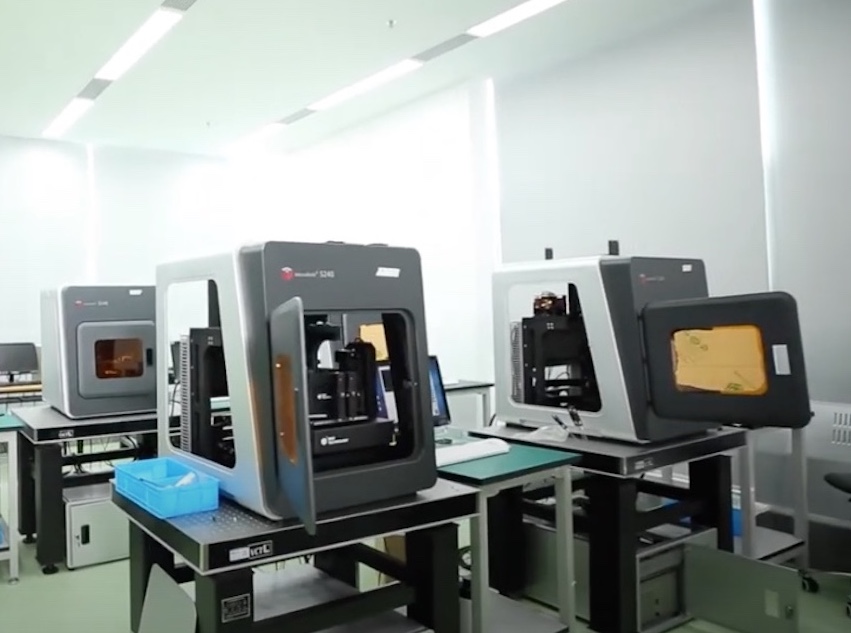Horizon Microtechnologies announces technology for 3D printing conductive components at a microscale
Subscribe to enable notifications and watch the 2022 3D Printing Industry Awards live on Tuesday, 13 December.
Horizon Microtechnologies, a microfabrication startup, has introduced a new microscale 3D printer technology at the Formnext tradeshow.
The firm’s template-based micro-additive manufacturing or ‘micro-AM’ process enables the creation of conductive parts with micrometer-level precision. The firm has now brought its technology to market and says it can help increase manufacturing flexibility in the production of electrodes.
“Template-based 3D microfabrication is effectively a mechanism to exploit the usefulness of polymer micro-AM produced 3D microstructures (the template) for hitherto unserved areas of industry. This is a real game-changer,” explains the firm’s CEO Andreas Frölich. “Horizon Microtechnologies bridges the gap between micro-AM and parts with enhanced functionality through the use of proprietary post-build processes.”

Template-Based 3D Microfabrication
Horizon Microtechnologies is known for its 3D template-based microfabrication technology. The firm claims that its technology is more functional than other offerings in this field, and that its post-build processes have improved functionality.
This allows users to switch up the way they deploy parts by giving them desirable properties such as heat resistance. Users can also microscale print with ceramics and metals in a way that unlocks functionalities such conductivity.
The technology coats parts created by polymer 3D printing using a conductive layer, either completely or in part. This process can even be used to coat areas that are difficult to reach, such as long channels and undercuts.
“The key enabling technology for our processes is micro-AM, and today a number of commercially viable polymer-based micro-AM platforms exist that can achieve exacting tolerances, quickly, cost-effectively, and above all repeatably,” adds Frölich. “However, these platforms are almost exclusively restricted to the production of parts in resin or plastics.”

Implementing micro-AM in practice
At Formnext, Frölich launched its technology alongside fellow micro-3D printing innovator Boston Micro Fabrication. As he presented the process to industry leaders, the company’s CEO explained how microfabricated 3D templates can also be coated with metal oxides, to prepare parts for use in hostile environments where chemicals are present.
This allows for the creation of microfluidic devices and complex nozzles that can be used around acids and solvents. The latter, in particular, are said to benefit from Horizon Microtechnologies’ post-print processes, which allow for the surfaces in contact with liquids to be coated. These can be used to improve wetting behavior, control surface energie, and introduce conductivity.
Elsewhere, when it comes to producing ESD-safe parts, Horizon Microtechnologies’ process is capable of controllably coating conductive surfaces, including those hidden inside internal channels. This technology is particularly useful in manufacturing compact, high-performance, ESD-safe end-effectors for vacuum pickup-and-place devices. They are sufficiently conductive to prevent ESD discharge.
In addition to marketing its micro-AM technology via contract manufacturing services, Horizon Microtechnologies now offers to help customers with R&D as a development partner. The firm’s unique understanding of 3D microfabrication (including its 2PP and Atomic Layer Deposition 3D printing experiences) allows it to help customers move from design to prototype to mass production.

Horizon Microtechnologies was on the Formnext stage with one of the most prominent microfabrication experts in the industry. In July this year, Boston Micro Fabrication raised $43 million in Series C funding to support its plans to double its global install base, invest in product R&D and build out its marketing team.
Nanoscribe, a 2PP additive manufacturing specialist, has also made a mark in the industry. It launched the Quantum X align 3-D printer in January 2022. At launch, the firm’s high-precision microprinter was reportedly the first of its kind to be capable of printing freeform micro-optical elements onto optical fibers and photonic chips.
To stay up to date with the latest 3D printing news, don’t forget to subscribe to the 3D Printing Industry Newsletter Follow us on Twitter Like our page Facebook.
While you’re here, why not subscribe to our Youtube channel? You will find discussion, debriefs and replays of webinars.
Are you looking to find a job in additive manufacturing? Visit 3D Printing Jobs For a list of available roles in the industry.
The featured image is a Horizon Microtechnologies-3D printed electronic device. Photo by Horizon Microtechnologies.